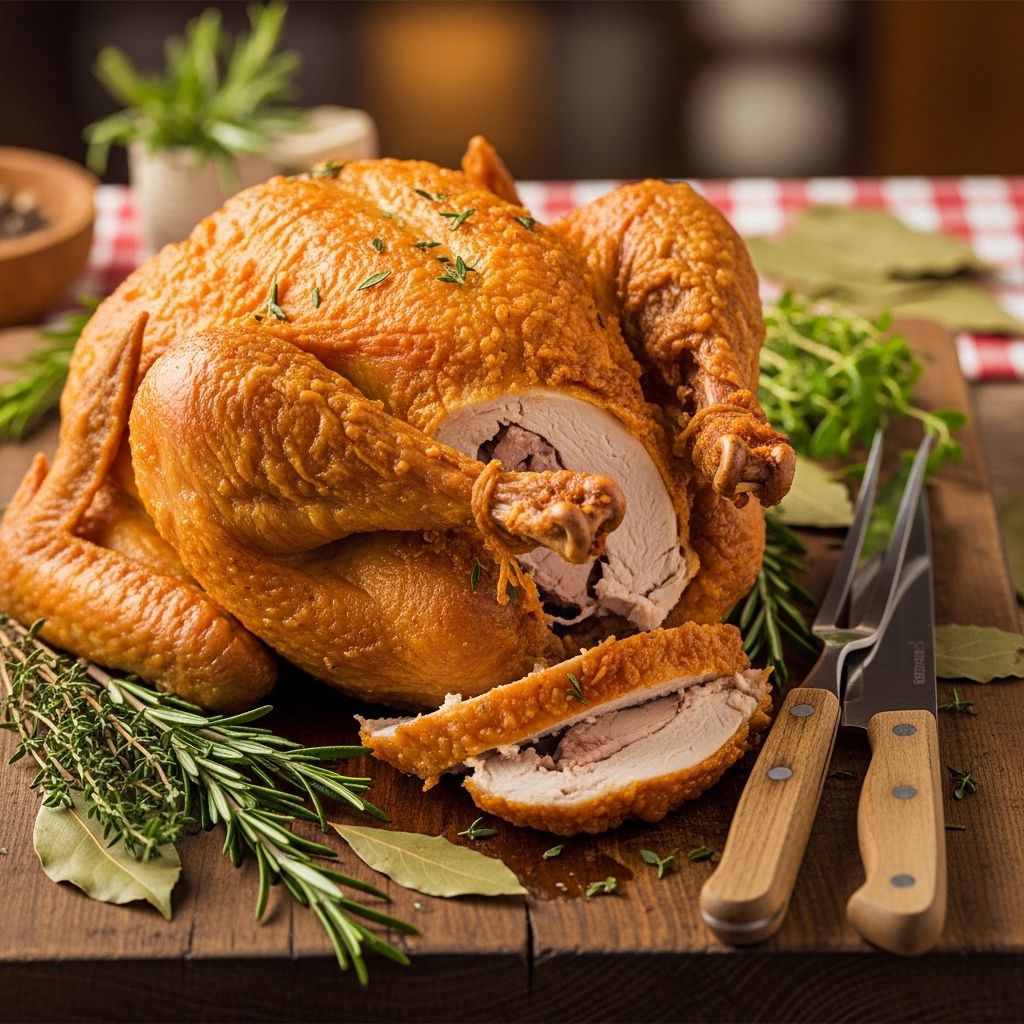The Ultimate Guide to Deep-Fried Turkey: Recipe, Tips, and Safety
Master safe outdoor frying with foolproof tips for crisp skin and juicy meat every time.

The Ultimate Guide to Deep-Fried Turkey
Deep-fried turkey has gained popularity for its crisp skin, juicy interior, and lightning-fast cooking time compared to traditional oven roasting. However, this method requires proper preparation, equipment, and strict safety measures to ensure desirable results. Whether you’re making it for Thanksgiving, a holiday meal, or a special gathering, this comprehensive guide walks you through every step of the process.
Why Deep-Fry a Turkey?
- Crispy Skin: The intense heat of deep-frying gives turkey skin a crackling texture not easily achieved with roasting.
- Juicy Meat: Seals moisture inside, resulting in tender and flavorful meat.
- Faster Cooking: Whole birds typically cook in 45 minutes or less, depending on size.
- Exciting Flavor Options: Easily add spice rubs, marinades, and aromatics for custom results.
Ingredients and Equipment
Ingredients Needed
- 1 whole turkey (10 to 14 pounds is ideal for deep-frying)
- Kosher salt (for seasoning and dry-brining)
- Freshly ground black pepper (to taste)
- Peanut oil or another high smoke-point oil (at least 2 gallons, depending on the size of your pot and bird)
Necessary Equipment
- Large outdoor propane burner designed for frying
- Large stockpot (at least 30-quart capacity)
- Turkey frying rack or basket (allows for safe lowering/raising of the bird)
- Hook or lifting tool for handling the rack
- Long-stem deep-fry thermometer for oil temperature
- Meat thermometer for testing internal turkey temperature
- Fire extinguisher (rated for grease fires)
- Protective gear: heavy-duty gloves, apron, safety glasses
Preparation Steps
Thawing the Turkey
Completely thaw the turkey: If using a frozen bird, allow ample time for thawing in the refrigerator—a 12-pound turkey typically takes at least 3 days. Never attempt to deep-fry a partially frozen turkey, as this produces dangerous oil splatter and steam.
Dry-Brining
- Pat turkey dry inside and out with paper towels.
- Generously rub with kosher salt (and black pepper, if desired) under the skin and inside the cavity.
- Refrigerate uncovered for 12–24 hours. This dry-brining step improves seasoning throughout and helps skin crisp in the fryer.
Prepping the Bird
- Remove giblets and neck from the cavity.
- Trim excess fat near the cavity opening for better fit.
- Secure wings and legs close to the body to minimize splatter and ensure even cooking.
- Double-check that the bird is absolutely dry (oil and water do not mix).
Choosing and Measuring Oil
Peanut oil is the preferred choice due to its high smoke point and neutral flavor, but other neutral oils such as canola or corn may work. The amount of oil required depends on bird size and pot shape.
- Measure displacement: Place bird in fryer pot. Fill with water until bird is just covered.
- Remove turkey and mark water level. Discard water and thoroughly dry pot.
- Fill pot with oil to marked level (never exceed half-full for safety).
How to Deep-Fry Turkey: Step-by-Step
1. Set Up Your Frying Station
- Choose a stable outdoor area, far from structures, children, and pets.
- Never fry indoors or on wooden surfaces.
2. Heat Oil
- Place oil in pot and attach deep-frying thermometer.
- Heat oil to 325–350°F (163–177°C). Avoid exceeding this temperature to prevent smoking or burning.
3. Prepare the Turkey
- Place turkey onto frying rack, legs pointing up.
- Double-check that the bird is bone-dry.
4. Lower the Bird Safely
- Turn off the burner before lowering the turkey into hot oil to minimize risk.
- Slowly and steadily lower the rack into the oil until completely submerged.
- Restart the burner after bird is safely in the oil.
5. Frying Time and Temperature
- Monitor oil temperature constantly, keeping within 325–350°F.
- Fry for 3–4 minutes per pound. For a 12-pound bird, expect 36–48 minutes.
- Check internal temperature with a meat thermometer after estimated cooking time. Target: 165°F (74°C) in the deepest part of breast and thigh.
6. Remove and Rest
- Turn off burner and carefully raise turkey from oil.
- Transfer to a wire rack over a sheet pan to drain excess oil.
- Let rest for 20–30 minutes before carving; this allows juices to redistribute.
Carving and Serving
Slicing a deep-fried turkey is the same as with roast turkey. Use a sharp carving knife to cut along the joints, separate breast meat, thighs, legs, and wings. The fried skin will be crisp and golden, while the meat inside remains moist and full-flavored.
| Turkey Weight | Estimated Frying Time | Recommended Oil Amount |
|---|---|---|
| 10 lbs | 30–40 mins | ~2.5 gallons |
| 12 lbs | 36–48 mins | ~3 gallons |
| 14 lbs | 42–56 mins | ~3.5 gallons |
Expert Tips for the Best Deep-Fried Turkey
- Dry everything: Water causes violent oil splatter. Dry bird, pot, and utensils thoroughly before beginning.
- Keep temperature steady: Oil too hot will burn the skin; oil too cold makes for greasy turkey.
- Season under the skin: Add herbs, spices, or aromatics under the skin before frying for extra flavor.
- Marinate or inject: Consider marinating or injecting seasoned stock for subtle taste and juiciness.
- Monitor oil clarity: Strain and reuse peanut oil after frying if desired; discard if cloudy or off-smelling.
Safety Precautions
- Never fry indoors: Always deep-fry turkey outdoors, away from flammable surfaces and objects.
- Have a fire extinguisher handy: Use only fire extinguishers rated for oil and grease fires.
- Use stable surfaces: Avoid uneven patios, grass, or wood deck.
- Don’t exceed recommended oil level: Overfilling oils can cause dangerous overflow when the bird is added.
- Wear protective gear: Heat-resistant gloves, aprons, and eye protection are strongly recommended.
- Keep children and pets away: Hot oil poses severe hazards.
Note: Never put a frozen or wet turkey into hot oil—this is the leading cause of turkey fryer accidents. Always consult the burner and fryer manufacturer for specific safety requirements.
Troubleshooting & Common Mistakes
- Turkey too large: Don’t attempt to fry birds over 14 lbs. Larger turkeys won’t cook evenly and are hard to handle safely.
- Oil too hot/cold: Constantly monitor the temperature with a deep-fry thermometer.
- Soggy skin: Result of low oil temperature or insufficient drying prior to frying.
- Meat undercooked: Always confirm internal temperature; fry longer in small increments as needed.
Flavor Variations and Serving Ideas
- Cajun rub: Blend paprika, cayenne, garlic powder, onion powder, and dried thyme for classic Southern spice.
- Asian marinade: Mix soy sauce, ginger, garlic, and a splash of sesame oil—inject or marinate if desired.
- Lemon-herb: Place lemon slices, rosemary, and thyme under the skin.
- Serve with side dishes such as cornbread stuffing, cranberry relish, or green beans for a festive holiday spread.
Frequently Asked Questions (FAQs)
Q: Why is peanut oil preferred over other oils?
A: Peanut oil has a high smoke point (~450°F), meaning it can withstand deep-frying temperatures without burning. Its neutral flavor also won’t conflict with turkey’s taste.
Q: How do I know when the turkey is fully cooked?
A: Insert a meat thermometer into the deepest part of the breast and thigh. The safe internal temperature is 165°F (74°C).
Q: Can I reuse frying oil?
A: Yes, you can reuse filtered peanut oil a couple of times. Let oil cool completely, strain out any particles, and store in a sealed container until next use. Discard if the oil becomes cloudy or develops odors.
Q: What should I do if oil starts to smoke?
A: Immediately turn off the flame. Smoking oil is dangerously hot and can ignite. Allow oil to cool before continuing.
Q: Is it safe to fry turkey with stuffing inside?
A: No. For food safety and consistent results, always fry turkey without stuffing. Prepare stuffing separately and serve on the side.
Q: Why did my skin come out soggy?
A: Soggy skin typically means the oil was not hot enough or the turkey was not dried thoroughly prior to cooking.
Conclusion
Deep-fried turkey delivers bold flavor and irresistibly crisp skin, but requires some planning and careful technique. Adhere to safety guidelines and preparation instructions, and you’ll have a show-stopping centerpiece fit for any gathering. Whether you prefer classic simplicity or creative twists, this method guarantees fast, delicious results every time.
Read full bio of Shinta












